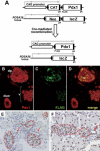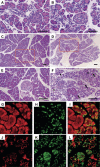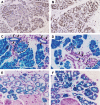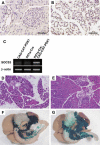Persistent expression of PDX-1 in the pancreas causes acinar-to-ductal metaplasia through Stat3 activation
- PMID: 16751181
- PMCID: PMC1475756
- DOI: 10.1101/gad.1412806
Persistent expression of PDX-1 in the pancreas causes acinar-to-ductal metaplasia through Stat3 activation
Abstract
The transcription factor pancreatic and duodenal homeobox factor 1 (PDX-1) is expressed in pancreatic progenitor cells. In exocrine pancreas, PDX-1 is down-regulated during late development, while re-up-regulation of PDX-1 has been reported in pancreatic cancer and pancreatitis. To determine whether sustained expression of PDX-1 could affect pancreas development, PDX-1 was constitutively expressed in all pancreatic lineages by transgenic approaches. The transgenic pancreas was markedly small with the replacement of acinar cells by duct-like structures, accompanied by activated Stat3. Genetic ablation of Stat3 in the transgenic pancreas profoundly suppressed the metaplastic phenotype. These results provide a mechanism of pancreatic metaplasia by which persistent PDX-1 expression cell-autonomously induces acinar-to-ductal transition through Stat3 activation.
Figures





References
-
- Bockman D.E. Morphology of the exocrine pancreas related to pancreatitis. Microsc. Res. Tech. 1997;37:509–519. - PubMed
-
- Edlund H. Pancreatic organogenesis—Developmental mechanisms and implications for therapy. Nat. Rev. Genet. 2002;3:524–532. - PubMed
-
- Fujitani Y., Fujitani S., Boyer D.F., Gannon M., Kawaguchi Y., Ray M., Shiota M., Stein R.W., Magnuson M.A., Wright C.V. Targeted deletion of a cis-regulatory region reveals differential gene dosage requirements for Pdx1 in foregut organ differentiation and pancreas formation. Genes & Dev. 2006;20:253–266. - PMC - PubMed
-
- Greten F.R., Weber C.K., Greten T.F., Schneider G., Wagner M., Adler G., Schmid R.M. Stat3 and NF-κB activation prevents apoptosis in pancreatic carcinogenesis. Gastroenterology. 2002;123:2052–2063. - PubMed
-
- Grippo P.J., Nowlin P.S., Cassaday R.D., Sandgren E.P. Cell-specific transgene expression from a widely transcribed promoter using Cre/lox in mice. Genesis. 2002;32:277–286. - PubMed
Publication types
MeSH terms
Substances
LinkOut - more resources
Full Text Sources
Other Literature Sources
Molecular Biology Databases
Research Materials
Miscellaneous
